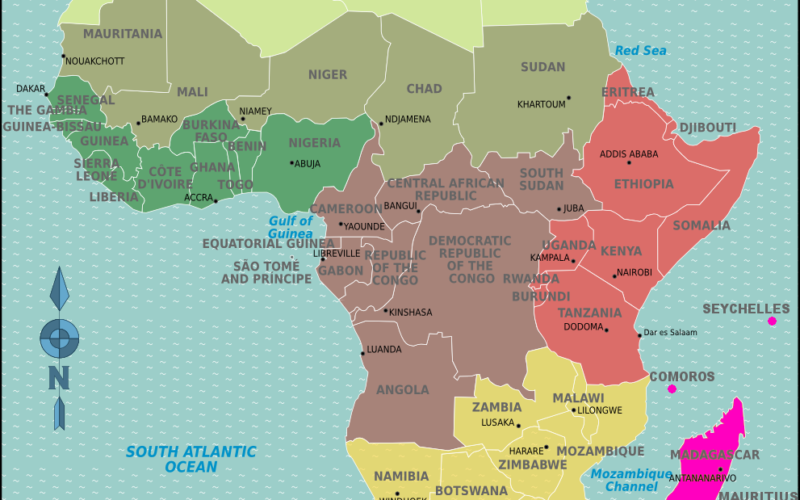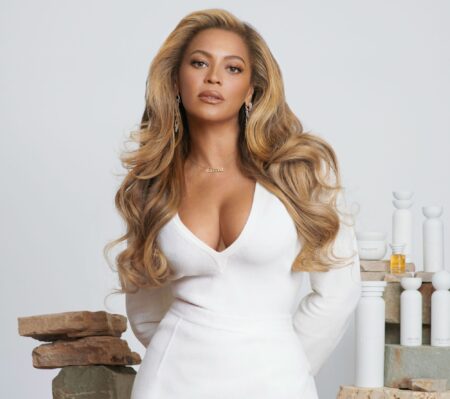This week, we are spotlighting Afro-futurist Jameel Amman as he debuts his series, honoring the ancestors. Amman’s series, titled “Mwen Sévi Lwa Vol. 1”, pays homage to not only historical figures but also to family members who have passed away.
In this interview with TheHub.news, the esteemed talks about the inspiration behind his breathtaking new series.








TheHub.news: Can you share with us the inspiration behind your artistic journey and the themes that often appear in your work?
Jameel Amman: My work is motivated by a yearning to experience that which is sacred or the divine, to bring that ineffable reality closer to me through ritualistic creative practices and to embody it on an energetic level. The resulting art is my way of communicating how I’m relating to the spiritual dimension, the Creator and my ancestors at that particular moment.
TheHub.news: How does your cultural background and identity influence your creative process and the messages you convey through your art?
JA: My cultural background is diverse and layered, which is manifested in the diversity of my creative expression. Religiously, I was raised in both the Catholic church and the Baptist church, and my work draws upon the sacred art of both traditions. As a figure painter, Catholic iconography is the foundation for my relationship to that craft. In this sense, I always see the human as a sacred being, which is why I consistently gravitate towards portraiture as my creative home, and this is also why I take a prayerful, sincere, and intentional approach to every person I draw or paint.
Digging deeper into my cultural background, both of my parents are musicians, traditions that they inherited from their parents, and I grew up playing a wide array of musical instruments. My parents and grandparents modeled a discipline and rigor towards musicianship that I bring with me to my work. On one hand, I have a daily drawing practice that is, to me, a form of shedding. On the other hand, as a virtual reality developer, I compose and produce music to accompany my VR projects. The Africana culture of New Orleans also has a huge influence in my work. My father is a jazz trumpeter in a traditional New Orleans brass band, and my work draws heavily on the energy and spirituality of New Orleans jazz.
TheHub.news: Could you describe the artistic techniques and mediums you prefer to work with and how they contribute to the uniqueness of your pieces?
JA: My main media, at this point in time, are: charcoal, oil/acrylic paint, virtual reality, and music production. I’ve been fascinated with charcoal and oil paint for the past 10 years. Charcoal is a very expressive drawing medium that offers a greater range of lights and shadows than graphite while also offering more dynamic textures. For my current series, I chose charcoal for a number of reasons: 1. The symbolism of charred trees seemed fitting for a series dedicated to African ancestors, 2. The reductive method that I used was a great way to symbolize the in-betweenness of ancestors (as a felt presence despite being physically absent), and 3. The value range of charcoal creates a beautiful palette for depicting Black skin.
I’ve been working in virtual reality for the past five years and that medium opens up a whole world of creative possibilities that traditional 2D media do not, mainly the access to full immersion and multi-sensory experiences. Through VR, I can create entire worlds that don’t physically exist, which lends itself to visualizing spiritual themes as well as re-imagining antiquity or projecting visions of the future. Also, VR allows me to create immersive experiences where viewers can engage multiple senses; for instance, you can be physically aware of your body in space while manipulating a virtual object and listening to a unique soundscape.
TheHub.news: Many of your artworks seem to address important social or political issues. Can you elaborate on the messages you aim to convey through your art?
JA: The consistent message throughout my work is liberation for African people. Liberation is more than a simple change of circumstance for African people; rather, it is the process of restoring our communities to wholeness and reclaiming our social, political and economic power. For me, that work begins with one’s spiritual life. The world as it has been disfigured by whiteness has so severely disconnected African people from our indigenous traditions that many of us are in need of serious healing and re-membering.
Once healed of yurugu’s poison, we must also connect with the many political traditions of maroonage and resistance. I intentionally use my art as a vehicle for highlighting African freedom fighters across various fields. To go deeper into this, the title of my current project is ‘Mwen Sevi Lwa,’ which pays homage to my Haitian Creole heritage. I’m immensely proud of that heritage as it connects me to that tradition of self-determination. Moreover, the first portraits that I completed for that series were the portraits of Omar Ibn Said (a formerly enslaved African who wrote his autobiography in his native Arabic) and Fannie Lou Hamer (the great freedom fighter and labor organizer from Mississippi).
Through my art, I want the message to be abundantly clear that African people are immensely greater than the figment of the white imagination that we have been forced to see in art and media. I want my work to be a clarion call for awakening what Baba Asa G. Hilliard called ‘the maroon spirit within us.’

TheHub.news: Are there any specific artists, Black or otherwise, who have had a significant impact on your artistic style or perspective?
JA: As a graduate of the Xavier University of Louisiana, I spent years studying many of the great African artists from New Orleans: John T. Scott, Numa Rousseve, Frank Hayden, Terrance Osborne, Ron Bechet, Steve Prince and Willie Birch, to name a few. Willie Birch’s charcoal drawings had a great impact on me and my choice to use charcoal as a medium.
Beyond those artists, I’ve been heavily influenced by Aaron Douglas, Pheoris West, Lois Mailou Jones, Elizabeth Catlett, Henry Ossawa Tanner and Charles White. Recently, I have begun studying the works of AfriCOBRA, specifically the vibrant prints of Wadsworth Jarrell and Barbara Jones-Hogu.
TheHub.news: Art often has the power to evoke emotions and spark conversations. How do you hope viewers react to and engage with your creations?
JA: I hope that my work evokes a sense of awe and wonder. Especially for Africans raised in the West, it’s so rare to see images of ourselves and our cultures that capture our souls and inspire us to cultivate our innate divinity. I want my art to provoke in others the feeling I felt when I first heard Pharoah Sanders’ The Creator Has a Master Plan. By that, I mean I want my art to speak to that interior space where the beauty, the pain, the joy, and the sorrow of the human experience feel harmonious and leave the viewer with a sense of wonder and longing.
Conversationally, I want my art to spark introspection, critical awareness, and deep study. I want those who experience my work to leave with a greater awareness of the depth of African culture, history and thought, and I want to inspire them to do the individual and communal work of Sankofa.
TheHub.news: Can you talk about a specific artwork of yours that holds special meaning to you and share the story behind its creation?
My recent portrait series has several portraits that are meaningful to me. However, the most meaningful one is the portrait of my grandparents, Ernest and Betty Paulin. In that portrait, I depict them standing shoulder to shoulder (a pose that always reminds me of Egyptian sculptures of royalty). That portrait features three focal points: my grandparents and the candle sitting on the table; the candle holds special significance to me as someone raised in the Catholic church and spent years as an altar server. I intentionally drew the candle in such a way that it appears to be glowing, which in Catholic theology is a symbol for the presence of God and spirit. This portrait is a prayer to my ancestors, a symbolic gesture that their spirits are always alive.
TheHub.news: What advice would you give to aspiring Black artists who are looking to make their mark in the art world and have their voices heard?
JA: To young Black artists who are graduating high school and who are ready to enroll in college, I encourage them to apply to an HBCU (Historically Black College or University). While the material conditions may be frustrating, I cannot emphasize enough how much creative energy is freed when you’re surrounded by people who look like you and who understand the culture you come from. When young Black artists study art at a PWI (predominantly white institution) (and I say this as a tenure-track art professor at a PWI), too much mental energy is spent reacting to white supremacy that you don’t have the bandwidth to tap into your innate genius; you spend much of your time either educating peers and professors on the Black experience, or convincing them that your genuine creative interests are important, or responding to overt and covert aggressions through your art, or forgetting yourself in the fog of whiteness and slip into the trap of assimilation.
Also, I would encourage you to keep friends around you who don’t identify as artists or artsy; they will be a great sounding board for your ideas. As you go through formal art education, it’s easy to get swept up in the clique-ishness of the art world and make work that responds to other people’s work or other people’s criticisms of your work. By showing your work to ‘non-art’ friends that you trust or talking out a new project with them, they’ll help you spot when you’re being inauthentic.
To young Black artists who have no interest in formal art education, I would encourage you to become involved with local creative Black communities. Find or create a group where you can meet regularly to sketch, paint, study, or just hang out. Look around for local artists who can be a mentor or an elder and ask to spend time with them in their studio. Spend time at local Black-owned businesses, building relationships that can potentially turn into exhibition opportunities. Research art-focused organizations in the area to see what’s available to you in terms of grants, residencies, exhibitions, art classes, job opportunities, etc.
About Jameel Amman
Jameel Amman Paulin is a visual artist whose work is motivated by a profound love of African descendants. In his studio practice, he uses Afrofuturism as a means to explore the experiences, utopian visions, and aesthetic traditions of the African diaspora. As a visual artist who grew up during the hip-hop era and the digital age, Jameel’s relationship with Afrofuturism has been shaped by the evolution of digital technology and hip-hop music. Presently, Jameel Amman creates immersive digital soundscapes, using African art and music as the basis for developing virtual worlds.
You can find out more about Jameel Amman’s work over at his official website.
For more breadcrumbs (and a full meal), JOIN KNARRATIVE: https://www.knarrative.com; it’s the only way to get into #Knubia, where these classes are held live with a live chat.
To shop Go to:TheGlobalMajority








